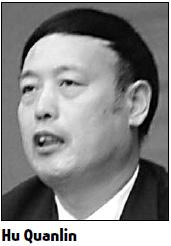Liaoning Spreads the Word about IPR
Liaoning provincial government recently released Situation of Intellectual Property Protection in 2008, which shows great improvement compared with the previous year. In an exclusive interview with China Business Weekly reporters Wu Yong and Liu Ce, Hu Quanlin, director of the Liaoning IPR Bureau, explained the province's IPR development and its government's efforts for improvement of IPR protection.

Q: How is the IPR development in Liaoning province, the traditional industrial center in North China?
A: Liaoning is a big province rather than a strong one in IPR.
The number of patent applications hit 20,895 last year, including innovation, utility model and design and so on. This can be ranked in the top 10 among 30 provinces and cities of the nation. So from this point of view, Liaoning is a big province in IPR. But the amount only accounts for one fifth of Guangdong, which ranked No 1 in IPR. So we say Liaoning is not a strong province in IPR.
The development of IPR is closely related to the local economy. Economically developed provinces and cities like Beijing, Shanghai and Guangdong attach great importance to IPR, because they develop very well and their products need to enter the global and national markets, which call for intellectual property protection. On the contrary, raw material industry with less technology is in the majority in Liaoning. As a result, there are fewer patents. Equipment manufacturing with hi-tech has flourished in recent years in Liaoning, so IPR became more and more necessary.
IPR has over 200 years' history and was introduced to China in 1984. The history in China is so short that the public has an inadequate understanding of it. People can copy any introduced technology or production when there's no patent law. And we thought this phenomenon was not wrong in the past. But now, it will infringe intellectual property rights if people copy a production in order to sell. In China, common people may not be aware of this. So it goes in Liaoning.
Q: Could you illustrate the development?
A: I can show you an example. Last year, Shenyang Machine Tool Group, famous for equipment manufacturing, wasn't praised as a hi-tech enterprise just because it didn't meet the requirement that a hi-tech company must have one innovation patent or six utility model patents. In fact, the group has hi-tech, but they didn't apply for patents since they had little sense of IPR.
The company has learned the lesson and applied for 28 patents just in the first quarter of 2009. Therefore, it's not that we don't have technology, but that we don't have sufficient knowledge of intellectual property rights.
As common people and enterprises lack IPR knowledge, we make publicity and training the top priority. The training can be divided into three levels:
The first level is the training on intellectual property retrieval according to the demands of enterprises and scientific research organizations. They can know the development state of a specific technology and if their technical topics have been overcome already through a retrieval system. The second level is to help entrepreneurs establish intellectual property strategy and enhance the competitiveness of companies. The third one is public education.
Q: Usually, the patent development develops fast, but the commercial application of new technology lags behind. What about this situation in Liaoning?
A: Liaoning has led the commercialization of patent technology in the nation. We have 30 million yuan in special funds, including 25 million yuan in basis funds and 5 million yuan allowance. This can be ranked as No 3 in the nation. We launched a project called "Intellectual Property Modeling at Selected Points". The amount of patent applications has doubled after years' efforts.
Enterprises should be the main body in innovation patents. But the actual situation is contrary in Liaoning. It reflects that our structure is irrational. We put the 5 million yuan allowance into guiding patent structural adjustment. We established an application fee waiver for enterprises that apply for patents to encourage them.
Also, companies can get financial support from the government in the whole process from R&D to industrialization. Now, the amount of patent applications has increased by 12 percent compared with 2007. And the amount of working position applications has increased by 23 percent.
Q: Sometimes, IPR protection has been a headache for a local government. Has Liaoning had some good experiences in this aspect?
A: We launched "Dual Hundred Projects" to protect patent techniques in 2007. We will select 100 industrial enterprises and 100 commercial ones as pilots to defend against patent infringement. In the past, we only investigated cases when someone came to report. It's too passive.
By now, 69 enterprises and 55 department stores have been selected and we guided them to establish a patent protection mechanism and support them to protect intellectual property rights.
Our key work in 2009 is to promote and implement Liaoning's Intellectual Property Strategy Outline, which published on Oct 28, 2008. Also, we will lay down the patent law. Meanwhile, we will strengthen law enforcement and team building.
What we have done in previous years is a foundation for attracting foreign investment. IPR is an important part of soft investment environment and it needs time to be perfect.
(China Daily 05/25/2009 page11)
2009-05-25
 Print
PrintRelated News
Photos
More>>trade
market
finance
- Commissioner Xie Fuzhan meets with the Visiting Delegation from Macau Statistics
- Delegation of Statistics Canada on Social Statistics Project Visited NBS
- Mr. Lin Xianyu Met with Japanese Statistical Delegation
- Mr. Xu Yifan Met with World Bank Mission
- Deputy Commissioner Zhang Weimin Meets with the Professor. Lepkowski from the





